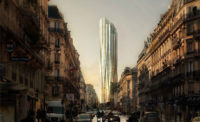Nestled in the meadows of Runnymede, a site-specific installation commissioned by the UK’s National Trust subtly honors events that took place in this lush countryside more than 800 years ago. It was here that feudal barons forced King John to put his seal on the Magna Carta—a document that established principles of individual rights and the rule of law. Named Writ in Water, a nod to British poet John Keats’s epitaph, the architectural artwork, designed by Turner Prize–winning artist Mark Wallinger with architecture firm Studio Octopi, relies on historical references and the permeating presence of the surrounding landscape to prompt contemplation.
Wallinger, who was originally selected as the sole designer, developed the underlying concept. Inspired by a medieval castle keep, he envisioned a cylindrical chamber containing a shallow pool with an oculus positioned directly above it. A clause from the Magna Carta would be engraved inside the pool’s metal ring. When the artist’s design took shape as a space people could occupy, the need for an architect became apparent, so Wallinger called on London-based Studio Octopi.
With their contribution, the architects sought to pay homage to both the passage of time and history by embedding subtle references, such as employing 52 Douglas fir rafters, which allude to the number of weeks in a year, as well as assessing every dimension of the project in cubits, an ancient form of measurement (the equivalent of 18 inches) based on the forearm.
“We wanted the building to feel as if you’re viewing it in the context of 800 years of history,” says firm cofounder James Lowe. To achieve this, the team created a textured wall from white cement with a gravel-and-sand aggregate sourced from local quarries. Pouring one layer of the mixture per day resulted in a structure that, through its striated surfaces, recalls its hillside and surrounding geology.
The oculus and pool in the inner chamber is an unexpected pairing that allows visitors to glimpse the treetops as well as the occasional plane flying to or from nearby Heathrow Airport. An imperceptible downward tilt of the rooftop overhang directs precipitation into the reflective pool, disrupting its calm surface. It’s a reminder, says Lowe, of how different interpretations of the Magna Carta make the document “something that is constantly moving, evolving, and being challenged.” Similarly, weather and changing landscapes ensure that each visit to Writ in Water will be unique.















